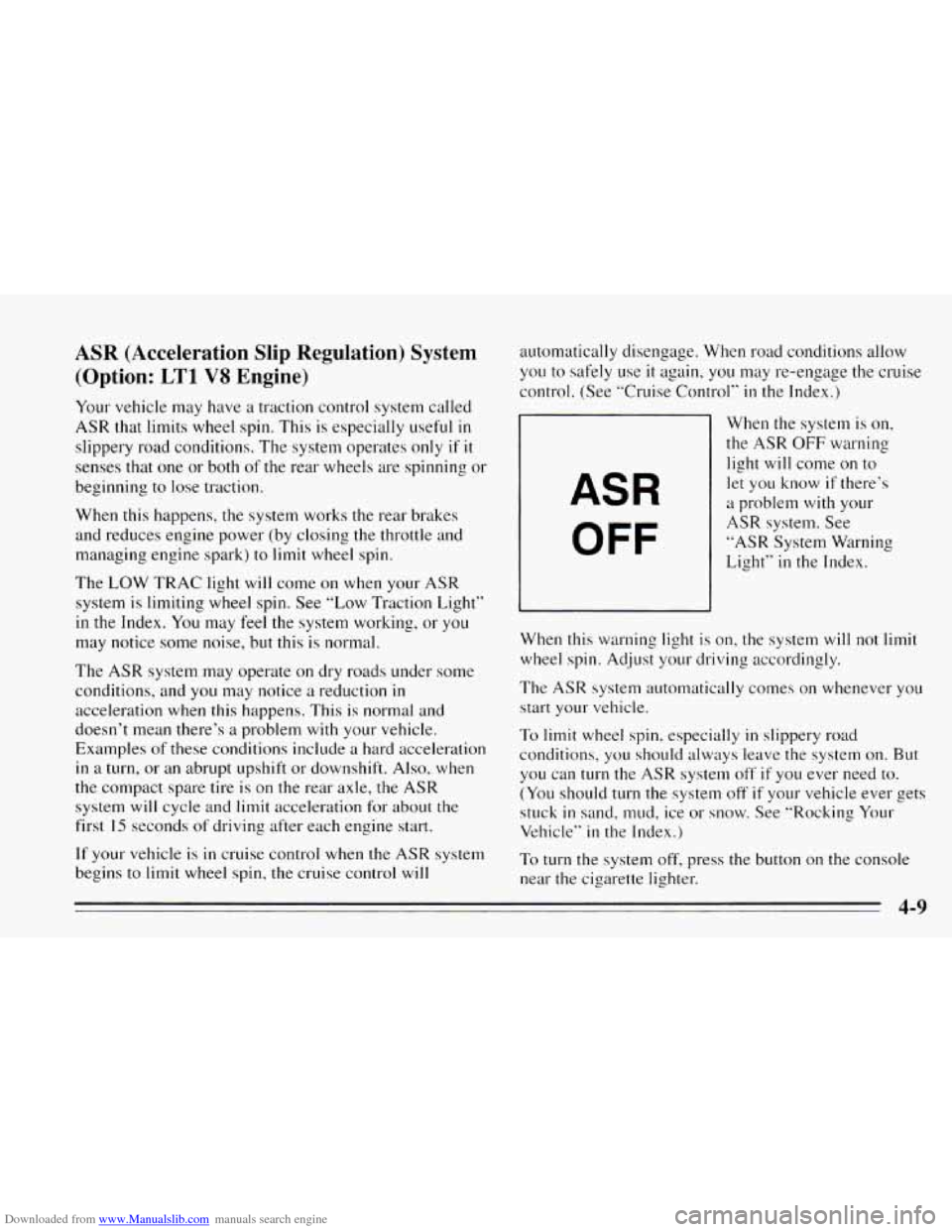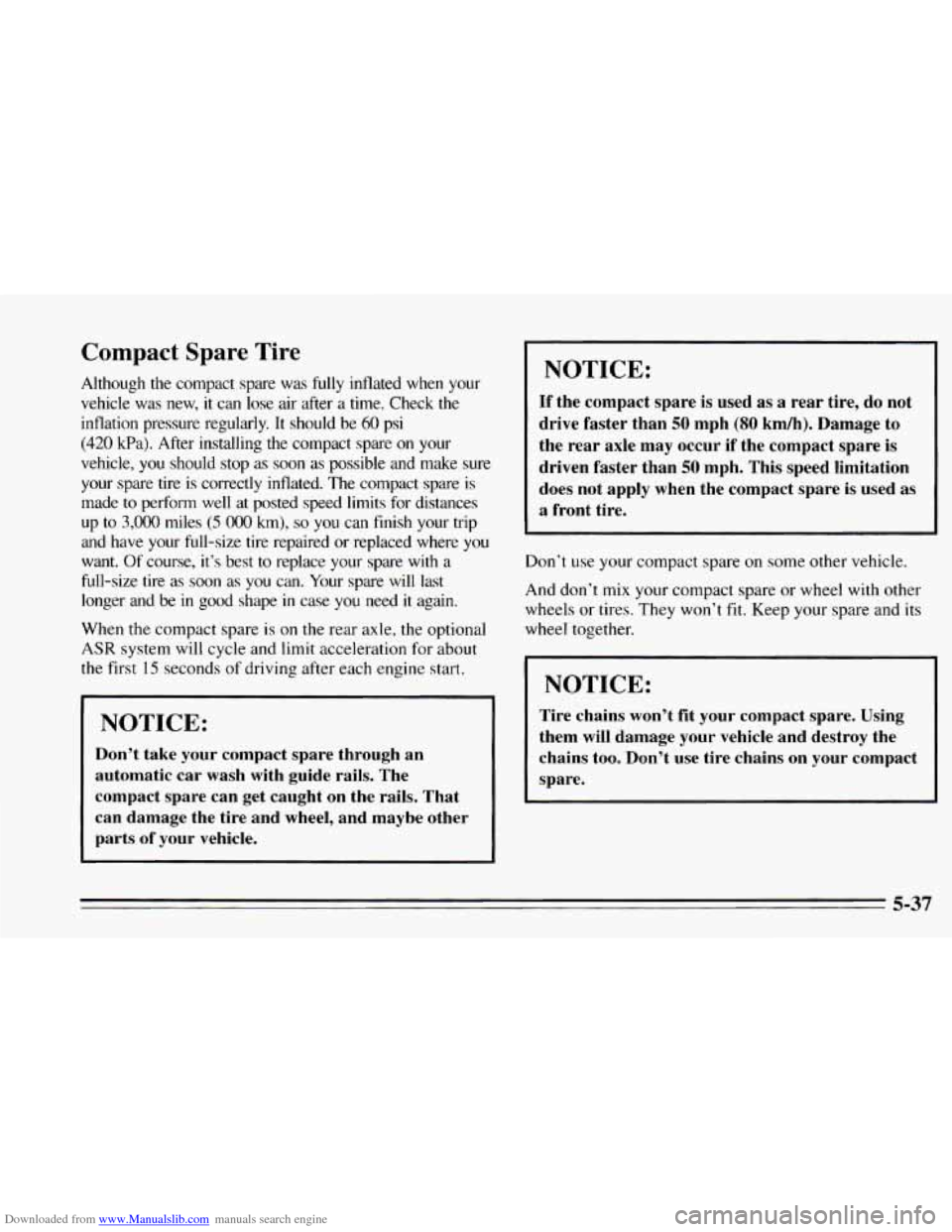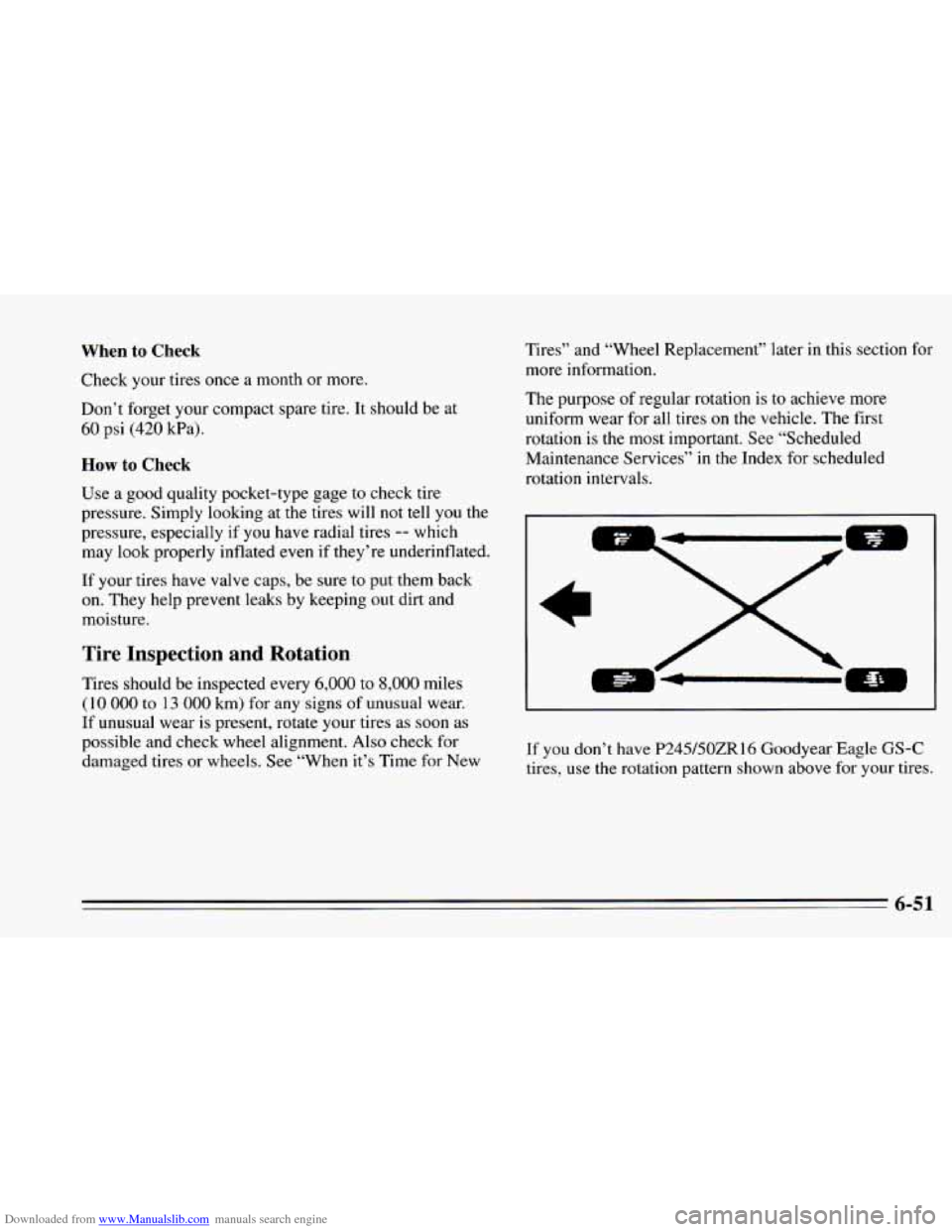Page 165 of 388

Downloaded from www.Manualslib.com manuals search engine ASR (Acceleration Slip Regulation) System
(Option: LT1 VS Engine)
Your vehicle may have a traction control system called
ASR that limits wheel spin. This is especially useful in
slippery road conditions. The system operates only if it
senses that one or both of the rear wheels are spinning or
beginning to lose traction.
When this happens, the system works the rear brakes
and reduces engine power (by closing the throttle and
managing engine spark)
to limit wheel spin.
The
LOW TRAC light will come on when your ASR
system is limiting wheel spin, See “Low Traction Light”
in the Index. You may feel the system working, or you
may notice some noise, but this is normal.
The
ASR system may operate on dry roads under some
conditions, and you may notice a reduction
in
acceleration when this happens. This is normal and
doesn’t mean there’s a problem with your vehicle.
Examples of these conditions include
a hard acceleration
in a turn, or an abrupt upshift or downshift. Also, when
the compact spare tire
is on the rear axle, the ASR
system will cycle and limit acceleration for about the
first
15 seconds of driving after each engine start.
If your vehicle is in cruise control when the ASR system
begins to
limit wheel spin, the cruise control will automatically
disengage. When road conditions allow
you to safely use
it again, you may re-engage the cruise
control. (See “Cruise Control”
in the Index.)
ASR
OFF
When the system is on,
the ASR OFF warning
light will come on to
let you know
if there’s
a problem with your
ASR system. See
“ASR System Warning
Light’’
in the Index.
When
this warning light is on, the system will not limit
wheel spin. Adjust your driving accordingly.
The
ASR system automatically comes on whenever you
start your vehicle.
To limit wheel spin, especially in slippery road
conditions,
you should always leave the system on. But
you can
turn the ASR system off if you ever need to.
(You should
turn the system off if your vehicle ever gets
stuck
in sand, mud, ice or snow. See “Rocking Your
Vehicle”
in the Index.)
To turn the system off, press the button
on the console
near the cigarette lighter.
4-9
Page 221 of 388
Downloaded from www.Manualslib.com manuals search engine The following steps will tell you how to use the jack and
change a tire. The
equipment
you’ll need is in the right (passenger)
rear area behind the trim panel.
First
you must remove the close-out panel. See
“Close-Out Panel’’
in the Index.
Find the plastic screw heads
in the trim panel over the
spare tire. Use a coin or a key
to turn the screw heads
until the slots point front and back to the unlock
position. Gently lift the trim panel front forward edge
and move
it out of the way.
5-27
Page 227 of 388
Downloaded from www.Manualslib.com manuals search engine NOTICE:
Raising your vehicle with the jack improperly
positioned will damage the vehicle or may allow
the vehicle to fall off the jack. Be sure to fit the
jack lift head into the proper location before raising your vehicle.
7I-T
a
a
Raise the vehicle by rotating the wheel wrench
clockwise. Raise the vehicle far enough
off the ground
so there is enough room for the spare tire to fit.
Remove all the wheel nuts and take
off the flat tire.
5-33
Page 229 of 388
Downloaded from www.Manualslib.com manuals search engine Lower the vehicle by rotating the wheel wrench
counterclockwise. Lower the jack completely.
Tighten the wheel nuts
firmly in a criss-cross
sequence as shown. Don’t
try to put a
wheel cover on your compact spare
tire.
It won’t fit. Store the wheel cover in the rear area
until
you have the flat tire repaired or replaced.
NOTICE:
Wheel covers won’t fit on your compact spare. If
you try to put a wheel cover on your compact
spare, you could damage the cover
or the spare.
5-35
Page 230 of 388
Downloaded from www.Manualslib.com manuals search engine Replace the jack, wheel wrench and flat tire using the
storage instructions. When you replace the trim panel,
be sure
to tuck it under the weatherstrip.
1.
2.
3.
4.
5.
6.
7.
8.
9.
10.
Trim Panel
Bolt
Cover
Jack Wing Nut
Adapter
Compact Spare Tire
Full-Size Tire
Carpet
Flap
Tire Storage Bolt
Page 231 of 388

Downloaded from www.Manualslib.com manuals search engine Compact Spare Tire
Although the compact spare was fully inflated when your
vehicle was new,
it can lose air after a time. Check the
inflation pressure regularly. It should be
60 psi
(420 kPa). After installing the compact spare on your
vehicle, you should stop as soon
as possible and make sure
your spare tire is correctly inflated.
The compact spare is
made
to perform well at posted speed limits for distances
up
to 3,000 miles (5 O00 km), so you can finish your trip
and have your full-size tire repaired or replaced where
you
want. Of course, it’s best to replace your spare with a
full-size tire as soon as you
can. Your spare will last
longer and be
in good shape in case you need it again.
When the compact spare is
on the rear axle, the optional
ASR system will cycle and limit acceleration for about
the first 15 seconds of driving after each engine start.
NOTICE:
Don’t take your compact spare through an
automatic car wash
with guide rails. The
compact spare can get caught on the rails. That
can damage the tire and wheel, and maybe other
parts
of your vehicle.
I
I NOTICE:
If the compact spare is used as a rear tire, do not
drive faster than
50 mph (80 km/h). Damage to
the rear axle may occur if the compact spare
is
driven faster than 50 mph. This speed limitation
does not apply when the compact spare is used
as
a front tire.
Don’t use your compact spare
on some other vehicle.
And don’t mix your compact spare or wheel with other
wheels or tires. They won’t fit. Keep your spare and its
wheel together.
I NOTICE:
Tire chains won’t fit your compact spare. Using
them will damage your vehicle and destroy the
chains too. Don’t use tire chains
on your compact
spare.
5-37
Page 281 of 388
Downloaded from www.Manualslib.com manuals search engine Tires
We don’t make tires. Your new vehicle comes with high
quality tires made by a leading tire manufacturer. These
tires are warranted by the tire manufacturers and their
warranties are delivered with every new Chevrolet. If
your spare tire is a different brand than
your road tires,
you will have a tire warranty folder from each of these
manufacturers.
6-49
Page 283 of 388

Downloaded from www.Manualslib.com manuals search engine When to Check
Check your tires once a month or more.
Don’t forget your compact spare tire. It should be at
60 psi (420 kPa).
DW to Check
use a good quality pocket-type gage to check tire
pressure. Simply looking at the tires will not tell you the
pressure, especially if you have radial tires
-- which
may look properly inflated even if they’re underinflated.
If your tires have valve caps, be sure to put them back
on. They help prevent leaks by keeping out dirt and
moisture.
Tire Inspection and Rotation
Tires should be inspected every 6,000 to 8,000 miles
(1 0 000 to 13 000 km) for any signs of unusual wear.
If unusual wear is present, rotate your tires as soon as
possible and check wheel alignment. Also check for
damaged tires or wheels. See “When it’s Time
for New Tires”
and “Wheel Replacement” later
in this section for
more information.
The purpose
of regular rotation is to achieve more
uniform wear for all tires on the vehicle. The first
rotation
is the most important. See “Scheduled
Maintenance Services”
in the Index for scheduled
rotation intervals.
-7 [*
If you don’t have P245/5OZR16 Goodyear Eagle GS-C
ires, use the rotation pattern shown above for your tires.
6-51